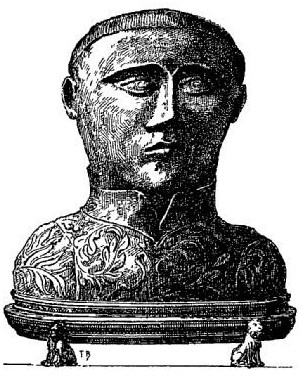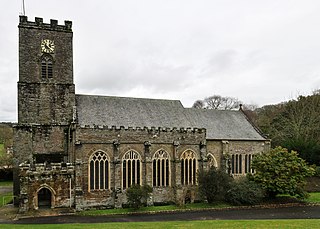
Piran or Pyran, died c. 480, was a 5th-century Cornish abbot and saint, possibly of Irish origin. He is the patron saint of tin-miners, and is also generally regarded as the patron saint of Cornwall, although Michael and Petroc also have some claim to this title.

Petroc or Petrock was a British prince and Christian saint.

Brioc was a 5th-century Welsh holy man who became the first abbot of Saint-Brieuc in Brittany. He is one of the seven founder saints of Brittany.
Kea was a late 5th-century British saint from the Hen Ogledd —the Brythonic-speaking parts of what is now southern Scotland and northern England. According to tradition he was chiefly active in Cornwall, Devon and Brittany, and his cult was popular in those regions as well as throughout Wales and the West Country. Fili or Filius, to whom the parish church of Philleigh is dedicated, probably came from Wales and is said to have been a companion of Kea.

Saint Sithney (Latin: Sidinius; Breton: Sezni Saint was a sub-Roman Celtic saint active in Cornwall and Brittany. He is invoked against mad dogs.

Mylor is a civil parish in Cornwall, England, United Kingdom. It is situated approximately five miles north of Falmouth.

Cubert is a village in Cornwall, England, United Kingdom. It is three miles (5 km) south-southwest of Newquay and is in the civil parish of Cubert.

St Martin-in-Meneage is a civil parish and village in the Meneage district of the Lizard Peninsula in Cornwall, England, United Kingdom.

Winwaloe was the founder and first abbot of Landévennec Abbey, also known as the Monastery of Winwaloe. It was just south of Brest in Brittany, now part of France.
Gilbert Hunter Doble was an Anglican priest and Cornish historian and hagiographer.

Mabyn, also known as Mabena, Mabon, etc., was a medieval Cornish saint. According to local Cornish tradition she was one of the many children of Brychan, king of Brycheiniog in Wales in the 5th century. The village and civil parish of St Mabyn is named for her, and the local St Mabyn Parish Church is dedicated to her.
Branwalator or Breward, also referred to as Branwalader, was a British saint whose relics lay at Milton Abbas in Dorset and Branscombe in Devon. Believed to come from Brittany, he also gives his name to the parish of Saint Brélade, Jersey. "Brelade" is a corruption of "Branwalader". He is also known as Breward or Branuvelladurus or Brélade and Broladre in French.
Amesbury Abbey was a Benedictine abbey of women at Amesbury in Wiltshire, England, founded by Queen Ælfthryth in about the year 979 on what may have been the site of an earlier monastery. The abbey was dissolved in 1177 by Henry II, who founded in its place a house of the Order of Fontevraud, known as Amesbury Priory.
Mewan was a Celtic saint active in Wales, Cornwall and Brittany. Most documentation of his life can be found in the Breton Vita Meveni, perhaps written in 1084 by Ingamar.

Christianity in Cornwall began in the 4th or 5th century AD when Western Christianity was introduced as in the rest of Roman Britain. Over time it became the official religion, superseding previous Celtic and Roman practices. Early Christianity in Cornwall was spread largely by the saints, including Saint Piran, the patron of the county. Cornwall, like other parts of Britain, is sometimes associated with the distinct collection of practices known as Celtic Christianity but was always in communion with the wider Catholic Church. The Cornish saints are commemorated in legends, churches and placenames.
Elwen was the name of an early saint or saints venerated in Cornwall and Brittany. The hagiographical material asserts that he came to Cornwall from Ireland in the company of Breage and six others, but this is attested late. A chapel at Porthleven in Sithney parish, Cornwall, dedicated to Elwen, existed from the 13th century until 1549, and in Brittany several sites and placenames are associated with possibly related figures.

The Meneage is a district in west Cornwall, United Kingdom. The nearest large towns are Falmouth and Helston.
Saint Sulien, Sulian, or Silin was the reputed 6th-century founder-abbot of a monastery at Luxulyan in Cornwall. His feast day is 29 July. He is likely the same as the Saint Sulien of Cornouaille and Domnonée. The prefix "lux" is equivalent to "loc" which means place. It is common in Brittany, but not in Cornwall, which suggests this is a Breton foundation.

The Church of St Mary and St Melor is the parish church of the town of Amesbury, Wiltshire. The Grade I listed church dates from the 12th century and may be connected with the 10th-century Amesbury Priory or its 12th-century successor, Amesbury Abbey.
Rumon of Tavistock is a saint venerated in the traditions of the Catholic, Anglican Communion, and Western Orthodox churches.












